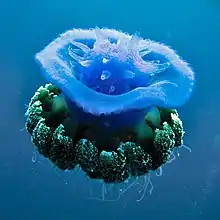Cephea cephea
Cephea cephea, also known as the crown jellyfish, or cauliflower jellyfish, is a species of jellyfish in the family Cepheidae.[1] It occurs in the tropical waters of the western Indo-Pacific to Northern Australia. The species was first described by Peter Forsskål in 1775 and originally given the name Medusa cephea. It inhabits the pelagic zone of tropical and sub-tropical waters and is most commonly found in the Indo-West Pacific, eastern Atlantic and the Red Sea. Although this species is among the most venomous jellyfish, it is not harmful to humans and is eaten as a delicacy and used for medical purposes in China and Japan. The species can achieve a diameter of up to 60 cm.
| Cephea cephea | |
|---|---|
 | |
| Scientific classification | |
| Domain: | Eukaryota |
| Kingdom: | Animalia |
| Phylum: | Cnidaria |
| Class: | Scyphozoa |
| Order: | Rhizostomeae |
| Family: | Cepheidae |
| Genus: | Cephea |
| Species: | C. cephea |
| Binomial name | |
| Cephea cephea Forsskål, 1775 | |
| Synonyms | |
| |
Description
Cephea cephea is purplish-blue in color and grow to up to 60 centimeters in diameter. This species has wart-like projections and a bell shape that is associated with the given common names for the species.[2] As in other jellyfish species, the tentacles contain nematocysts that are used to stun, kill and grapple prey items.[3] Its lifespan is approximately three to six months.[4]
Ecology
This species of jellyfish is known to live in the Pelagic zone of the ocean in the Indo-West Pacific, Eastern Atlantic and the Red Sea. They live and thrive in cold water and can be found as deep as over 3,000 feet below the surface. The species is bioluminescent. During the day it tends to remain in deeper waters, migrating to surface waters at night. Its prey mainly consists of algae, shrimp, plankton, invertebrate eggs and invertebrate larvae. The most common known predators of the species are sea turtles.[5]
Reproduction
The reproduction cycle is similar to many other jellyfish. Adults release sperm or egg into the water; fertilized eggs form planula larvae. The planula then attaches itself to a rock or similar structure that allows it to grow into a polyp. Asexual reproduction then occurs meaning the polyp essentially clones itself and develop into another stage called the ephyra. The last process is the growth and development into an adult medusa jellyfish.[6][3] Water temperature and food supply influence the efficiency of the asexual reproduction phase.[7]
Venom and human use
Cephea cephea is known to be one of the most venomous jellyfish. Although they have large amounts of venom deadly to their prey, their stings and venom is not harmful to humans. They are actually known to be eaten by humans located mostly in Japan and China. The dish is a delicacy in the Japanese and Chinese cultures. This particular species of jellyfish is used also used for medicinal purposes for humans.[8]
Gallery
References
- Collins, A. G.; Jarms, G.; Morandini, A. C. (2021). "World List of Scyphozoa. Cephea cephea (Forskål, 1775)". WoRMS. World Register of Marine Species. Retrieved 5 April 2021.
{{cite web}}: CS1 maint: multiple names: authors list (link) - "Types of Jellyfish [10 Different Jellyfish Species] | Ocean Scuba Dive". 2020-06-08. Retrieved 2021-04-05.
- "How do jellyfish reproduce? What effect does their sting have on humans? What's the difference between red and translucent jellyfish?". Scientific American. Retrieved 2021-04-06.
- "Crown Jellyfish". Exotic Aquaculture. Retrieved 2021-04-05.
- "Crown Jellyfish Fact Sheet". C.S.W.D. Retrieved 2021-04-05.
- Sugiura, Yasuo (1966). "On the Life-History of Rhizostome Medusae Iv. Cephea Cephea". Embryologia. 9 (2): 105–122. doi:10.1111/j.1440-169X.1966.tb00219.x. ISSN 1440-169X. PMID 4380167.
- Schiariti, A.; Morandini, AC; Jarms, G.; von Glehn Paes, R.; Franke, S.; Mianzan, H. (September 9, 2014). "Asexual reproduction strategies and blooming potential in Scyphozoa". MEPS. 510: 241. Bibcode:2014MEPS..510..241S. doi:10.3354/meps10798.
- Tokioka, T. (1964). "Occurrences of purplish individuals of Cephea cephea (forskal) in the vicinity of Seto" (PDF). Publications of the Seto Marine Biological Laboratory. 12 (2): 149–156. doi:10.5134/175360.



.jpg.webp)
